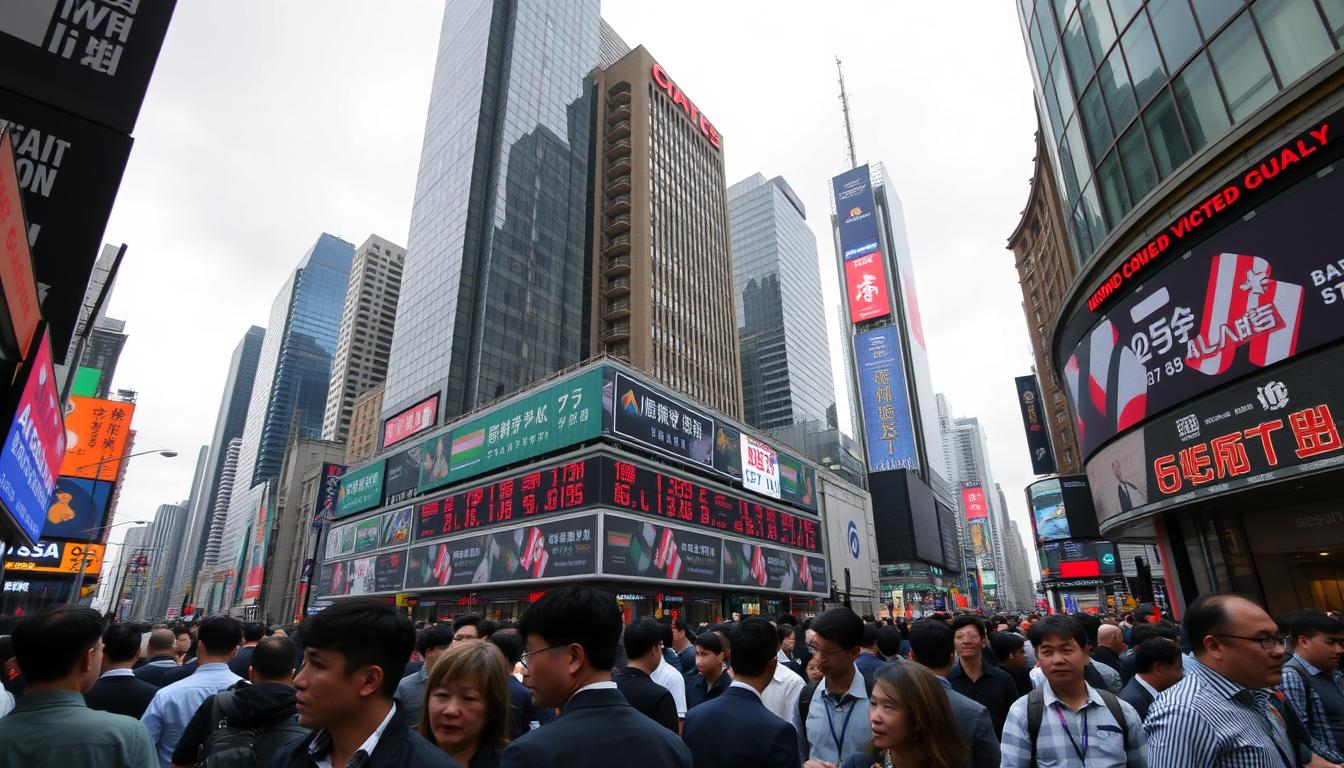Asian Stocks Drop on Nvidia Forecast Impact
The global tech world was hit hard by Nvidia’s disappointing financial forecast. This news has caused a big drop in Asian stock markets. Investors are now worried, leading to lower stock prices in major financial centers in Asia.
Nvidia, a leading American semiconductor company, surprised everyone with a revenue forecast that was lower than expected. This news has made investors less confident. They see Nvidia’s performance as a sign of how the whole semiconductor industry is doing.
Right after Nvidia’s forecast, Asian exchanges saw stocks in tech and related areas drop a lot. Investors are now more careful. They’re worried about the tech industry’s future and the economy’s health.
Key Takeaways
- Nvidia’s lower-than-expected revenue forecast has triggered a decline in Asian stocks, particularly in the technology sector.
- Investor sentiment has shifted towards a more risk-averse approach, reflecting concerns about the broader tech industry’s performance.
- The interconnectedness of global markets means that a single company’s forecast can have a significant impact on trading patterns across Asia.
- Analysts are closely monitoring the semiconductor industry’s performance metrics and supply chain implications for Asian tech companies.
- Investors are reevaluating their portfolio strategies and risk management techniques in response to the volatile market conditions.
Breaking Down Nvidia’s Forecast and Its Immediate Market Impact
Nvidia’s latest financial outlook has shaken the tech world. It has made investors less eager and changed how they trade on Asian exchanges. The company’s forecast was not as strong as expected, affecting investors’ risk appetite and the tech sector outlook.
Key Points from Nvidia’s Financial Projections
Nvidia’s forecast included important details that have influenced trading:
- A big drop in gaming GPU demand, due to too much stock and economic issues
- The company’s data center business grew slower than hoped, a key area for growth
- There are worries about semiconductor demand in the data center and car sectors
Initial Market Reactions Across Asian Exchanges
When Nvidia’s forecast came out, stock prices in major Asian markets fell. Shares of companies related to semiconductors dropped a lot. This affected the whole tech sector outlook.
Investors got nervous about the nvidia forecast and its effects on the industry. This led to a big sell-off, making investors more cautious.
Critical Data Points Affecting Trading Decisions
| Data Point | Impact on Trading |
|---|---|
| Nvidia’s revenue guidance cut | Caused a sell-off in semiconductor stocks, raising concerns about the industry’s nvidia forecast |
| Weakening demand for gaming GPUs | Pointed out the challenges facing the tech sector outlook and investors’ risk appetite |
| Slower-than-expected data center growth | Made people question the semiconductor demand in the data center market’s future |
As the industry deals with these key points, everyone will watch Nvidia’s forecast closely. They will see how it affects the tech sector and investment plans.
Asian stocks ease as Nvidia’s forecast dampens investors’ risk appetite
The Asian equity markets have seen a drop due to Nvidia’s bad financial forecast. Investors are worried about market volatility and economic uncertainty. This has made them think twice about their portfolio diversification plans.
Nvidia’s forecast of lower revenue for the current quarter has worried the equity markets. It has raised concerns about the technology sector’s health. Investors are watching closely, trying to understand the impact and make smart choices.
The have seen a slowdown in activity. Major indices in the region show a cautious mood. This shows how global markets are connected and how one forecast can affect everything.
With the technology sector in focus, analysts are advising caution. They say a balanced investment strategy is key. This is especially true as market volatility keeps going.
Technology Sector Ripple Effects Across Asian Markets
Nvidia’s gloomy forecast has shaken the technology sector in Asia. Investors are now cautious about the stock market’s future. The semiconductor industry is key to the region’s tech scene. It’s important to look at how key players are doing.
Semiconductor Industry Performance Metrics
The semiconductor industry in Asia is sending mixed signals. Some big chip makers are doing well, but others see demand drop. Analysts watch things like how busy factories are, how much stock is on hand, and profit margins.
Regional Tech Giants’ Stock Movement Patterns
Big tech names like Samsung, TSMC, and Alibaba have seen their stock prices swing. Investors are looking closely at their financial reports. They want to see how these companies handle supply chain issues and changes in what people want to buy.
Supply Chain Implications for Asian Tech Companies
The semiconductor industry’s impact on Asia’s tech supply chain is huge. Any problems could spread, hitting many tech companies. This includes chip makers, device makers, and software providers.
The semiconductor industry is vital for Asia’s tech sector. Understanding the complex relationships in this ecosystem is crucial. It’s important for investors and industry players to navigate these changes.
Market Sentiment Shifts in Major Asian Trading Hubs
Nvidia’s disappointing forecast has shaken the Asian markets. Investors in Tokyo, Hong Kong, and Shanghai are now more cautious. They are worried about the economic outlook and corporate earnings.
In Tokyo, the Nikkei 225 index has slightly dropped. This shows investors’ concerns in the region. Analysts say it’s because of worries about the semiconductor industry’s problems affecting Japan’s tech economy.
- Investors are watching tech giants like Sony and Panasonic. They worry about the global semiconductor shortage’s impact on their supply chains and production.
- Despite this, Japan’s economic outlook is still cautiously optimistic. The government’s efforts to boost growth are helping the market.
The Hong Kong Hang Seng index has also fallen. This reflects the investor confidence worries in the area. Hong Kong’s role as a financial hub makes it more sensitive to global market changes, especially in tech and semiconductors.
“The semiconductor industry’s challenges have cast a shadow of uncertainty over the corporate earnings prospects of many Hong Kong-listed tech companies, dampening investor enthusiasm,” said a local market analyst.
In Shanghai, the Shanghai Composite Index shows investors are hesitant. The economic outlook for China’s tech sector is under close watch. Manufacturers and suppliers are monitoring the semiconductor industry to see how it might affect their corporate earnings.
The changes in market sentiment in these major Asian trading hubs show how connected the global tech world is. A single sector’s problems can affect the whole economy. Investors are watching closely to see how this will impact the investor confidence, economic outlook, and corporate earnings in the long run.
Understanding the Semiconductor Industry’s Current Landscape
The semiconductor industry is key to the tech world. Nvidia’s forecast shows its importance. The demand for chips is growing fast, thanks to new tech like AI and 5G. But, the industry faces challenges in making enough chips, which could affect the future.
Global Chip Demand Analysis
The demand for semiconductors has been rising quickly. Experts say the market will grow by over 10% annually soon. This growth is driven by smart devices, IoT, and high-performance computing needs.
Production Capacity Concerns
The demand for semiconductors is high, but the industry is struggling to keep up. Global chip production capacity is limited by supply chain issues, politics, and a chip shortage. These problems cause delays and hurt the tech sector’s performance.
Future Growth Projections
Despite current issues, the industry is expected to grow. Analysts predict the global semiconductor industry will hit over $1 trillion by the end of the decade. This growth will be driven by advanced tech, 5G, electric vehicles, and renewable energy.
“The semiconductor industry is the heartbeat of the tech sector, and its future trajectory will have far-reaching implications for businesses and consumers alike.”
Impact on Regional Economic Indicators and Currency Markets
The tech sector’s recent shake-up, led by Nvidia’s bad forecast, has hit hard beyond just stocks. It’s affecting economic signs and currency values in Asia. As tech company futures look shaky, investors are watching for how it might spread to other markets.
Asian economies, which count on tech, are especially worried. Places like Taiwan, South Korea, and China depend a lot on chips and tech. If tech slows down, their exports might drop, hurting their factories and overall growth.
| Indicator | Impact | Affected Regions |
|---|---|---|
| Gross Domestic Product (GDP) | Potential downward revision in growth projections | Taiwan, South Korea, China |
| Industrial Production Index | Slowdown in manufacturing and related sectors | Taiwan, South Korea, China |
| Export Volumes | Decline in tech-related exports | Taiwan, South Korea, China |
Also, the ups and downs in tech stocks are making currency markets wobbly. Investors are moving money around, causing the Taiwanese dollar and South Korean won to swing wildly.
Now, as tech faces uncertainty, everyone is watching closely. Policymakers and experts are trying to figure out what it means for markets and the economy’s future.
Strategic Investment Approaches in Volatile Tech Markets
The tech sector is facing market volatility, and smart investors are finding ways to deal with it. A balanced portfolio and careful risk management are key. They help investors stay strong and keep their confidence up.
Portfolio Rebalancing Considerations
When tech markets are volatile, rebalancing your portfolio can help. It’s important to check your asset mix. You might need to adjust your tech stock holdings and look at other stable investments for growth.
Risk Management Techniques
- Diversifying investments across sectors and industries to reduce concentration risk
- Implementing stop-loss orders to limit potential losses
- Maintaining a cash reserve to capitalize on market dips and opportunities
- Closely monitoring economic indicators and industry trends to make informed decisions
Long-term Investment Strategies
Even with short-term ups and downs, keeping a long-term view is essential. Look for top tech companies with strong fundamentals and growth potential. By being disciplined and patient, investors can ride out the market and aim for long-term success.
“Volatility in the tech sector can be unnerving, but with the right risk management strategies and a long-term mindset, investors can navigate these challenges and capitalize on the industry’s resilience and potential for growth.”
Global Market Interconnections and Trading Patterns
The global economy is like a big web. Events in one place can quickly spread to markets all over. Nvidia’s forecast shows how connected today’s financial world is. It highlights the importance of understanding market mood, stock swings, and economic doubts.
When the semiconductor industry hits bumps, it affects more than just Nvidia. Asian markets have already seen big drops, especially in tech stocks. But the effects go beyond Asia, as investors rethink their plans and adjust to new market rules.
Experts predict more ups and downs and careful investor attitudes. To succeed, you need to get how the world’s markets are linked. You also have to spot new trends and risks. Smart investors will adjust their plans to grab chances while avoiding economic risks.
FAQ
What is the impact of Nvidia’s recent forecast on Asian stocks?
Nvidia’s forecast has caused Asian stocks to drop. This is because the tech company’s predictions have made investors less confident and less willing to take risks in the region.
What are the key points from Nvidia’s financial projections?
Nvidia’s financial outlook has raised concerns about the semiconductor industry. It points to a possible decrease in demand and issues with production capacity.
How have Asian markets reacted to Nvidia’s forecast?
Asian markets have reacted negatively to Nvidia’s forecast. Tech and semiconductor stocks have seen a lot of selling. Investors are adjusting their strategies.
What are the critical data points affecting trading decisions?
Important data includes global chip demand, production capacity, and future growth in the semiconductor industry. These factors are key in making trading decisions and influencing market mood.
How has the technology sector been impacted across Asian markets?
Nvidia’s forecast has affected the technology sector in Asia. Investors are watching semiconductor performance, stock movements of tech giants, and supply chain impacts on Asian tech companies.
How has market sentiment shifted in major Asian trading hubs?
Market sentiment has worsened in major Asian trading centers like Tokyo, Hong Kong, and Shanghai. This is due to Nvidia’s forecast’s impact on corporate earnings and the regional economy.
What is the current landscape of the semiconductor industry?
The semiconductor industry faces challenges like global chip demand, production capacity, and uncertain growth. These issues are important to understand Nvidia’s forecast’s context.
How has the impact on Asian markets affected regional economic indicators and currency markets?
Nvidia’s forecast has affected Asian economic indicators and currency markets. It has potential long-term effects on economies heavily reliant on the tech sector.
Investors might use portfolio rebalancing, risk management, and long-term strategies. These can help navigate tech market uncertainty and maintain confidence during volatility.
How do global market interconnections and trading patterns factor into the broader implications of Nvidia’s forecast?
Global market connections mean events in one area can quickly affect trading and sentiment worldwide. This highlights the need to consider Nvidia’s forecast’s impact on global stability and growth.





